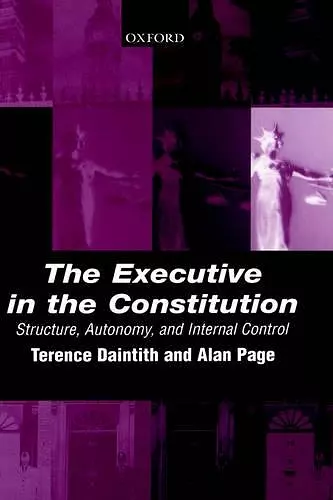The Executive in the Constitution
Structure, Autonomy, and Internal Control
Terence Daintith author Alan Page author
Format:Hardback
Publisher:Oxford University Press
Published:26th Aug '99
Currently unavailable, and unfortunately no date known when it will be back

The Executive in the Constitution: Structure, Autonomy, and Internal Control is the first constitutional and legal analysis of the inner workings of the executive for many years. It aims to provoke a reappraisal, by constitutional lawyers, of the place of the executive within the constitution, by exploring an area hitherto largely neglected in constitutional law: the legal foundations of the powers and structure of the executive, and the mechanisms through which the centre of the executive seeks to control the actions of departments. The authors, both pre-eminent in the field off constitutional law, show that the machinery of executive co-ordination and control is no less crucial a dimension of the constitutional order than the external machinery of democratic and legal control. These external parliamentary and judicial controls depend for their effectiveness on the executive's ability to control itself. The plural structure of the executive, however, makes the co-ordination and control of its component parts a highly problematical pursuit. Against the background of an analysis of the executive's legal structure, the book examines in detail the controls governing departmental access to staffing, financial, and legal resources, analysing the relationship between these internal controls and the external machinery of democratic and legal control, and showing how the machinery of internal control has been shaped by the structure of the executive branch. The organization of the executive and the way it controls the actions of its departments has changed significantly in recent year. This book explores the impact of the machinery if executive co-ordination and control of the ambitious public service reform project which has been pursued by successive governments over the last twenty years, as well as of changes in the wider constitutional framework, including those stemming from the United Kingdom's membership of the European Union and the growth of judicial review. It shows how public service reforms, judicial review, and European law are changing not just the inner life of the executive government but its place in the constitution as well.
this is a formidable addition to the literature of modern UK government and public administration, written from an unusual and innovative constitutional-legal perspective ... particuarly impressive in its skilful intermixing of historical analysis of traditional principles and a wide-ranging review of the implications of post-1979 public management reforms ... an extraordinary wealth of detail ... a useful and truly impressive book. * Gavin Drewry, New Institutionalism and Organizational Theory, a Review Article. *
Daintith and Page have presented us with a masterly and illuminating account of the various and significant ways in which the executive plays its part in the working of the constitution and in maintaining and implementing basic constitutional principles. Their book enriches our understanding of the modern constitution and of the place within it of an executive whose role should not any longer be undervalued. * Colin Turpin The Cambridge Law Journal July 2000 Vol.59 Part 2 *
This book will provide a useful reference for those who want to understand the formal mechanism for control on the fragmented Executive. * Martin J Smith, Govt and Opp. *
a formidable addition to the literature of modern UK government and public administration ... the book contains an extraordinary wealth of detail ... a useful and truly impressive book. * Gavin Drewry, Public Administration Vol 78 Issue 2 *
A wonderful description of current structures, processes, practices and rules which relate to the resources of the executive, its people, money and laws. * Brian Thompson, Parliamentary Affairs Vol.53 No.2 *
ISBN: 9780198268703
Dimensions: 242mm x 162mm x 29mm
Weight: 805g
441 pages